Meet Muriel Bowser in LeDroit Park tomorrow night

Mayor Muriel Bowser will attend the monthly meeting of the LeDroit Park Civic Association. Join us at the meeting tomorrow, Tuesday, February 24 at 7pm at the Florida Avenue Baptist Church (623 Florida Ave NW – enter at the back).
The Association will also vote on whether to oppose the application to build a roof deck and exterior stair at 1901 4th St NW.
The McMillan Fountain’s sibling sits in New York’s Bryant Park
A few months ago I stumbled on this fountain, the Lowell Memorial Fountain, in New York’s Bryant Park. Something looked familiar about it. It turns out it was designed by Charles A. Platt, who designed the McMillan Fountain that once stood at the McMillan Reservoir.
Back in 2011, we wrote about the McMillan Fountain, and how the lower half of the fountain now sits neglected in Fort Washington National Park.
A bicentennial map depicts LeDroit Park in 1975
DDOT posted this map of DC published in 1975 to celebrate the bicentennial. The map includes a section on LeDroit Park. Notice the groovy font, the “new” Howard University Hospital, the “nice old houses”, the long-gone bakery, and the “newly reopened Howard Theatre.” The Howard Theatre had briefly reopened from 1975 to 1980.
LeDroit Park appears in a Washington Post quiz
LeDroit Park appears in an online quiz, “How well do you know D.C. neighborhoods?” in the Washington Post. Question 3 asks you to identify the neighborhood known for its Victorian mansions. The answer is LeDroit Park.
Victorian architecture covers a range of styles, including revival styles, that became popular in the 19th century. What is unusual about LeDroit Park is that it has 12 distinct architectural styles that were popular in the Victorian era. Builders in other neighborhoods typically restricted themselves to a smaller range of styles.
LeDroit Park was a hot market in 1978, but much more affordable than today
A neighbor pointed us to this 1978 article in the Washington Star naming LeDroit Park the neighborhood with the highest annual appreciation in single-family home assessments. Home values increased 51% in just two years.
Much of the increase was attributed to Howard University’s purchase of homes in the neighborhood. The university has since divested itself of nearly all single-family houses here.
The average neighborhood assessment back then, according to the assessor quoted in the article, was about $25,000. Even in 1978 that was considered low and the figure was about 1.5 times the District’s median household income in 1979, which was $16,211. In 2013 the average sales price of a LeDroit Park home (including condos) was $562,029, which was 9.2 times the District’s median household income in 2013, which was $60,675.
LeDroit Park Market building owner seeks historic exception
The owners of the 1901 4th Street, which currently houses the new LeDroit Park Market, are appealing a denial from the Historic Preservation Review Board (HPRB) to add a roof deck and exterior stair to the building.
The owners sought permission to add a 10′-by-14′ deck to the roof of the building, partly hidden by the parapet and gables at the roof’s edge. An exterior stair would be built above the garage, would be visible from 4th Street, and would connect the house to the roof deck.
The Historic Preservation Office (HPO) staff report summarized the project and recommended that HPRB deny the application for the following reasons:
- The exterior access stair would be visible from 4th Street and “would create a very prominent and modern intrusion into the character of the historic district.” Furthermore, the stair’s extension to four feet above the height of the roof would “alter the perceived dimensions” of the building and further obstruct the view of neighboring rowhouses.
- Though roof decks are sometimes permitted when they do not demolish historic features and are not visible from the street, HPO staff worried that this deck, placed close to the building’s edge, “cannot guarantee that the furniture, illumination and activity associated with a roof deck would also not be visible.” Furthermore, HPO staff noted that no contributing buildings in the LeDroit Park Historic District have roof decks (which is not entirely true).
At its September 18th meeting, HPRB voted to deny the application, following the HPO staff recommendation. The owners are appealing the denial to the Mayor’s Agent, a position created to review special historic preservation cases and grant exceptions to the rules under limited circumstances:
- If historic preservation rules would place an “unreasonable hardship” on the property owner.
- If the proposed project is “necessary in the public interest”.
- If the proposed project will deliver “significant benefits to the District of Columbia or to the community by virtue of exemplary architecture, specific features of land planning, or social or other benefits having a high priority for community services.”
Few appeals to the Mayor’s Agent ever succeed and those that do are typically public or public-private projects. In 2009 the Mayor’s Agent permitted the Third Church of Christ, Scientist, to demolish its brutalist sanctuary near the White House since the building’s upkeep was a financial burden to the church. In 2012 the modernization of a historic firehouse in Cleveland Park was deemed “necessary in the public interest” since modern firetrucks required the widening of the historic firehouse’s doors. In 1980 the Mayor’s Agent permitted the demolition of historic buildings to create the original convention center, deeming it a project of “special merit”.
The owner’s renovation of this historic property is certainly welcome. However, it is hard to argue that being denied a roof deck is an “unreasonable hardship” or that the construction of a roof deck is “necessary in the public interest” like a firehouse, or that a roof deck will deliver “significant benefits” to DC or the community like a convention center.
Nonetheless, the Mayor’s Agent will hold a public hearing on this case on Friday, February 27, 2015, at 9:30 am at the Office of Planning (1100 4th Street SW, Suite E650). Read these details if you wish to testify.
Here is the full HPO staff report:
Edward Brooke, a LeDroit Park native and US Senator, has died

On Saturday, Edward Brooke, a LeDroit Park native and the first popularly elected African-American in the U.S. Senate died at age 95. Mr. Brooke grew up at 1938 3rd Street (pictured below) in LeDroit Park, attended Dunbar High School, and graduated from Howard University in 1941.
After serving in World War II, in which he was awarded a Bronze Star Medal, he moved to Boston and graduated from Boston University Law School. He practiced law in Boston and ran for office several times, usually as a Republican. The idea of a black New England Republican seems like an impossibility today, but the party was more ideologically diverse in that era and Mr. Brooke was part of its now-extinct liberal wing.
Mr. Brooke was elected Attorney General of Massachusetts in 1962 and the state’s voters elected him to represent them in the U.S. Senate in 1966. Mr. Brooke was the first African-American popularly elected to the U.S. Senate.
U.S. Senators were typically appointed by state governments until the ratification of the 17th Amendment in 1913. During Reconstruction the Mississippi state government was under Federal control, meaning those in power were Northern newcomers or abolitionist Southerners with liberal views on race relations. Under this short-lived political alignment, the Mississippi legislature appointed two black Republicans to the U.S. Senate, but their terms were short. Pressure from the former Confederate establishment and political intimidation from white supremacist groups ensured that when the Mississippi government was released from Federal control, new legislators quickly put Jim Crow laws into place. No African-American entered the Senate again until Mr. Brooke in 1966.
Mr. Brooke’s biggest policy achievements include co-sponsoring the Fair Housing Act of 1968 and the 1969 Housing Act’s so-called Brooke Amendment, which limited public housing rent to 25% of the tenant’s income.
In 2004, Pres. Bush awarded Mr. Brooke the Presidential Medal of Freedom and in 2009 Congress awarded Mr. Brooke a Congressional Gold Medal.
He died on Saturday at age 95 at his home in Coral Gables, Florida. Below is a photo of his childhood home in LeDroit Park.
1925 photo of Griffith Stadium also shows LeDroit Park
Every time I come across a photo of Griffith Stadium, which stood where Howard University Hospital now stands, I look carefully for an angle of LeDroit Park. By way of Ghosts of DC comes this superb 1925 aerial shot looking north at the stadium and part of the neighborhood.
The east-west street in the foreground is the 500 and 600 blocks of U Street NW. Zoom in and look around. Notice the streetcars on Georgia Avenue in the upper-left corner of the photo. Notice the previous incarnation of the Florida Avenue Baptist Church in the lower-left corner.
The stands beyond Griffith’s straightaway center field backed up to 5th Street from Elm to V Streets. Can you imagine hearing the crack of a bat and roar of crowds during a Senators game?
Also note what’s no longer standing. All but seven houses pictured east and north of the stadium have since been demolished, replaced with parking garages, parking lots, public housing, or academic buildings. Nearly all of these houses would be illegal to rebuild today under our 1950s zoning code, which mandates minimum lot sizes and house widths to which much of historic LeDroit Park does not conform.
Photo source: National Archives
LeDroit Park fast became a fashionable neighborhood

We found this 1875 article about LeDroit Park’s fast-growing population from 1875. This was just as the neighborhood was being developed as “suburb” of Washington City.
Local News.
Evening Star
October 9, 1875AN INTERESTING ITEM, showing the growth of the city to the north, is the fact that eighteen months ago only two families lived at LeDroit Park, while now more than twenty families make it their residence, and the demand for homes in that beautiful locality is far beyond the supply.
Download a PDF of the original story. You can browse the entire Evening Star online with your DC library card.
New maps chart LeDroit Park’s architects and development history
The Historic Preservation Office’s newly released 2016 Historic Preservation Plan has some good maps about LeDroit Park’s historic architecture and development.
Architects
Though James H. McGill designed the neighborhood’s original eclectic country houses, architects A. H. Beers, George S. Cooper, N. T. Haller, and A. E. Landvoight designed much of the neighborhood’s subsequent housing. (Click any of the following maps for larger versions)
Builders
If you research your house’s original building permit at the Washingtoniana Division of the MLK Library, you will find that it lists both an architect and a builder. The builder typically hired the architect and arranged for the financing and sale or lease of the finished product. The McGill-designed houses were built by A. L. Barber & Co., but other builders included Barr & Sanner, W. R. Coon, George C. Hough, Harry A. Kite, and Thomas W. McCubbin.
Contributing Structures
Not every building in a historic district is historic or worthy of preservation. The National Park Service defines a contributing structure as one that “by location, design, setting, materials, workmanship, feeling, and association adds to the district’s sense of time and place, and historical development.” A non-contributing building can include “one where the location, design, setting, materials, workmanship, feeling, and association have been so altered or have so deteriorated that the overall integrity of the building has been irretrievably lost.” Also, buildings built within the past 50 years are typically considered non-contributing. (The “50-year Rule” is a common, if controversial, historic designation threshold.)
Date of Construction
The McGill houses were built between 1873 and 1883. After that other lots were sold off and developed as rowhouses. Some McGill houses were torn down and replaced with smaller rowhouses.
All of the above maps are from page 69 of the Historic Preservation Office’s report.

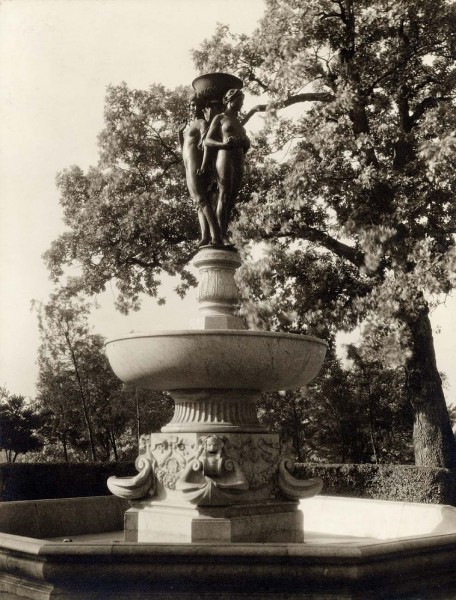
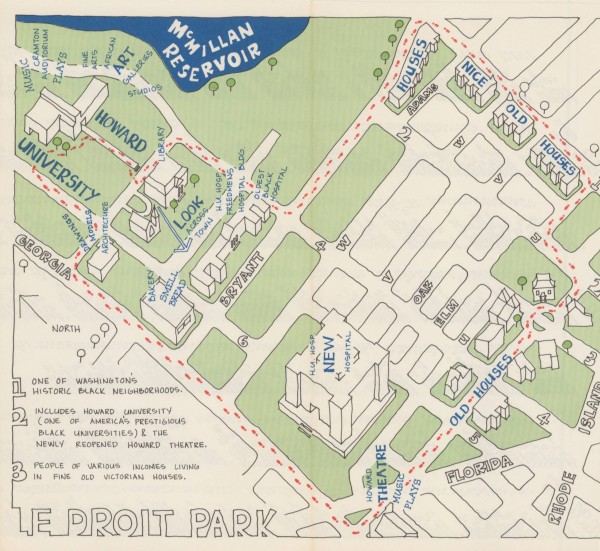
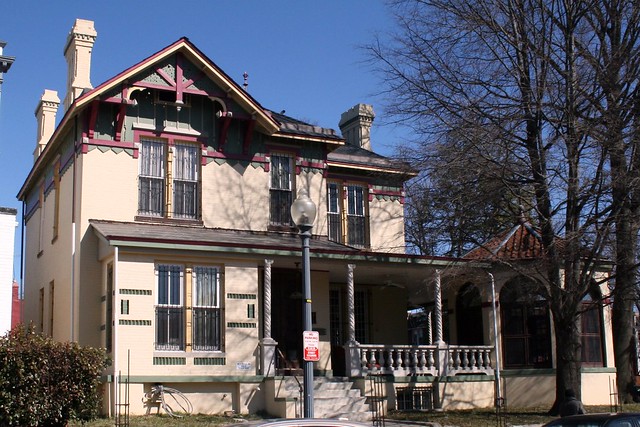
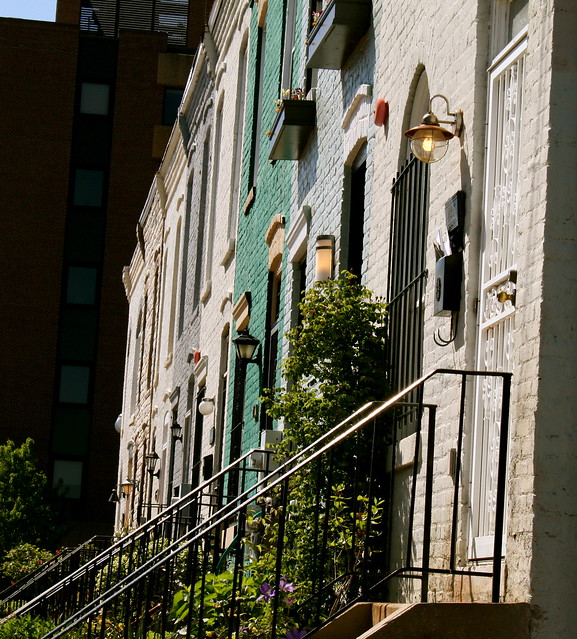

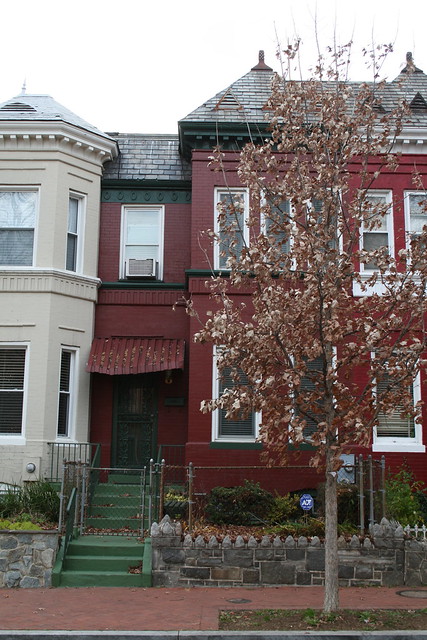
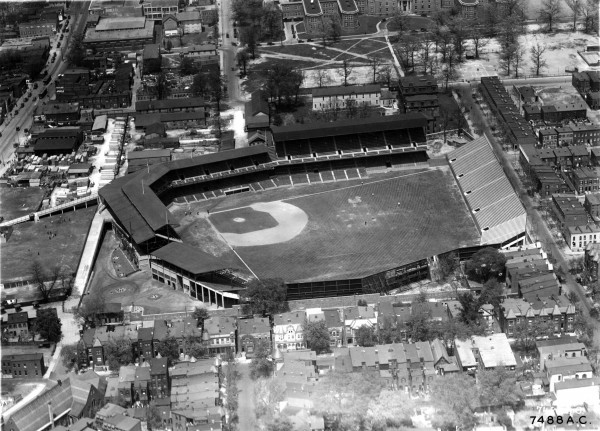

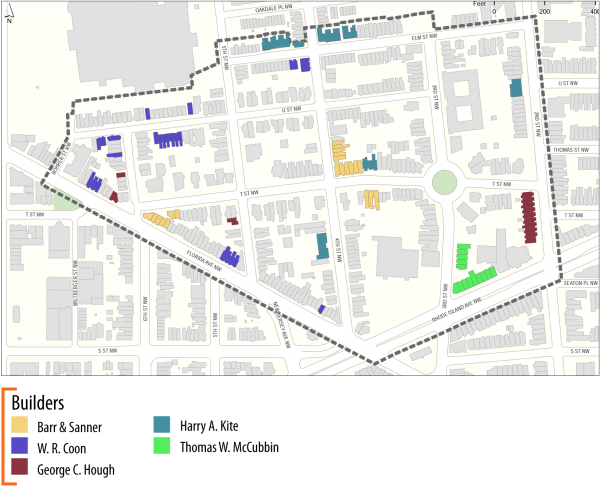

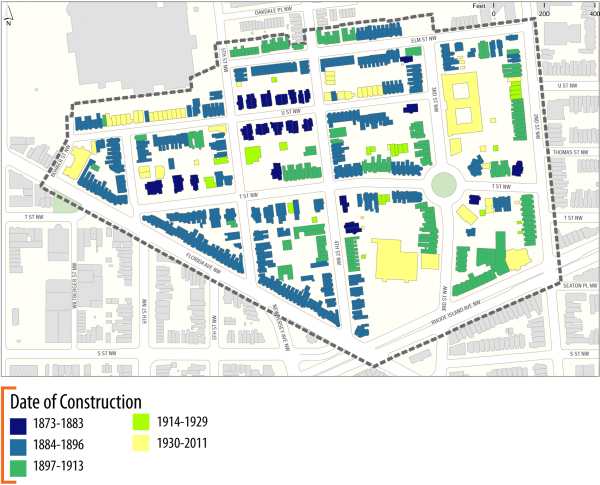






Recent Comments